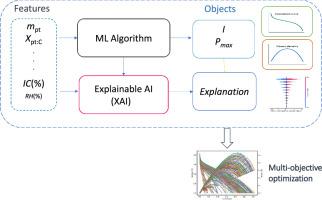聚合物电解质燃料电池的数据驱动建模:用可解释的人工智能进行预测分析
IF 9.6
Q1 COMPUTER SCIENCE, ARTIFICIAL INTELLIGENCE
引用次数: 0
摘要
聚合物电解质燃料电池将成为新兴氢经济的关键技术。然而,优化它们的成本和性能需要了解不同的参数如何影响它们的运行。这个优化问题涉及许多相互关联的设计和操作参数。然而,仅仅通过实验研究来发展所需的理解是低效的。物理模型是对实验的一种急需的补充,但它受到简化假设的限制,削弱了模型的预测能力。作为实验和物理建模的补充,我们采用基于数据的评估,利用机器学习技术来支持和增强决策。我们首先利用广泛的实验数据集评估各种机器学习模型(包括人工神经网络)的预测准确性,以预测聚合物电解质燃料电池的极化行为。然后,我们应用可解释的人工智能技术,包括基尼特征重要性和Shapley加性解释值分析,以了解这些模型如何将数据纳入预测过程。概率分析可以帮助确定预测和特征值之间的关系。我们证明了Shapley加性解释值分析的见解与相关电化学反应和输运过程的热力学和动力学的文献数据是一致的。我们的研究强调了可解释和可解释工具的潜力,以提供各种相关操作和设计参数对燃料电池性能的影响的整体分析。在未来,这种可解释的工具可以帮助确定实验数据中的差距,并确定研究重点。本文章由计算机程序翻译,如有差异,请以英文原文为准。

Data-driven modeling of polymer electrolyte fuel cells: Towards predictive analytics with explainable artificial intelligence
Polymer electrolyte fuel cells will be an essential technology of the emerging hydrogen economy. However, optimizing their cost and performance necessitates understanding of how different parameters affect their operation. This optimization problem involves numerous interrelated design and operational parameters. However, developing the required understanding through experimental studies alone would be inefficient. Physical modelling is a much-needed complement to experiment but is constrained by simplifying assumptions that diminish the models' predictive capabilities. As a supplement to experiment and physical modelling, we employ a data-based assessment that leverages machine learning techniques to support and enhance decision-making. We first evaluate the predictive accuracy of various machine learning models, including artificial neural networks, to predict the polarization behavior of polymer electrolyte fuel cells, harnessing an extensive experimental dataset. We then apply explainable artificial intelligence techniques, including Gini feature importance and Shapley additive explanations value analyses, to understand how these models incorporate data into the prediction process. Probabilistic analyses can help identify relationships between predictions and feature values. We demonstrate that insights derived from Shapley additive explanations value analysis are consistent with literature data on the thermodynamics and kinetics of relevant electrochemical reaction and transport processes. Our study highlights the potential of interpretable and explainable tools to offer a holistic analysis of the impacts of various interrelated operational and design parameters on the performance of the fuel cell. In the future, such explainable tools could help identify gaps in experimental data and pinpoint research priorities.
求助全文
通过发布文献求助,成功后即可免费获取论文全文。
去求助
来源期刊

Energy and AI
Engineering-Engineering (miscellaneous)
CiteScore
16.50
自引率
0.00%
发文量
64
审稿时长
56 days
 求助内容:
求助内容: 应助结果提醒方式:
应助结果提醒方式:


